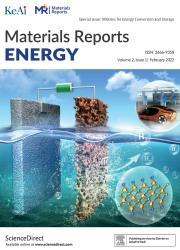基于单体结构设计和交联三维网络的超稳定锂金属电池用聚合离子-液体固体聚合物电解质
IF 13.8
引用次数: 0
摘要
固体聚合物电解质(spe)因其安全性、易于包装、成本效益、优异的灵活性和稳定性而受到广泛关注。聚二氧索烷(PDOL)具有与锂金属阳极(lma)良好的相容性和原位聚合性能,是极具发展前景的SPEs基体材料之一。但其热稳定性差、离子电导率不足、电化学稳定窗口(ESW)窄,阻碍了其在锂金属电池(lmb)中的进一步应用。为了改善这些问题,我们成功地用咪唑阳离子偶联TFSI -阴离子修饰DOL,合成了一种名为DIMTFSI的聚合离子液体(PIL)单体,同时继承了DOL的亲脂性、咪唑的高离子电导率和PIL优异的稳定性。然后引入三叉交联剂三甲基丙烷三[3-(2-甲基-1-叠氮吡啶)丙酸盐](TTMAP)来调节过量的Li+- o配位,制备出热稳定性好、ESW宽、离子电导率高、Li+转移数(tLi+)丰富的阻燃剂SPE (DT-SPE)。结果表明,LiFePO4|DT-SPE|锂电池在0.2C和30°C条件下具有149.60 mAh g−1的高初始放电比容量,循环500次后容量保持率为98.68%。这项工作为长循环lmb的结构设计提供了新的见解,具有高安全性和稳定性。本文章由计算机程序翻译,如有差异,请以英文原文为准。

Polymerized-ionic-liquid-based solid polymer electrolyte for ultra-stable lithium metal batteries enabled by structural design of monomer and crosslinked 3D network
Solid polymer electrolytes (SPEs) have attracted much attention for their safety, ease of packaging, cost-effectiveness, excellent flexibility and stability. Poly-dioxolane (PDOL) is one of the most promising matrix materials of SPEs due to its remarkable compatibility with lithium metal anodes (LMAs) and suitability for in-situ polymerization. However, poor thermal stability, insufficient ionic conductivity and narrow electrochemical stability window (ESW) hinder its further application in lithium metal batteries (LMBs). To ameliorate these problems, we have successfully synthesized a polymerized-ionic-liquid (PIL) monomer named DIMTFSI by modifying DOL with imidazolium cation coupled with TFSI− anion, which simultaneously inherits the lipophilicity of DOL, high ionic conductivity of imidazole, and excellent stability of PILs. Then the tridentate crosslinker trimethylolpropane tris[3-(2-methyl-1-aziridine)propionate] (TTMAP) was introduced to regulate the excessive Li+-O coordination and prepare a flame-retardant SPE (DT-SPE) with prominent thermal stability, wide ESW, high ionic conductivity and abundant Li+ transference numbers (tLi+). As a result, the LiFePO4|DT-SPE|Li cell exhibits a high initial discharge specific capacity of 149.60 mAh g−1 at 0.2C and 30 °C with a capacity retention rate of 98.68% after 500 cycles. This work provides new insights into the structural design of PIL-based electrolytes for long-cycling LMBs with high safety and stability.
求助全文
通过发布文献求助,成功后即可免费获取论文全文。
去求助
来源期刊

材料导报:能源(英文)
Renewable Energy, Sustainability and the Environment, Nanotechnology
CiteScore
13.00
自引率
0.00%
发文量
0
审稿时长
50 days
 求助内容:
求助内容: 应助结果提醒方式:
应助结果提醒方式:


